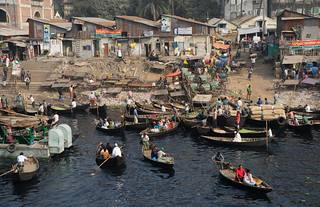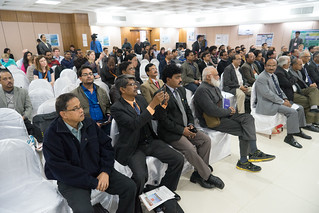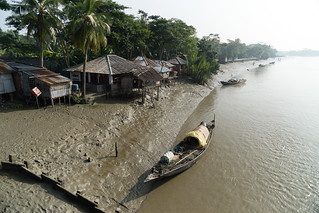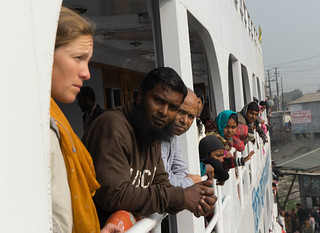We rushed from the Sundarbans to Dhaka in order to attend the Gobeshona Climate Change Conference. This conference, organized by the International Centre for Climate Change and Development (ICCCAD) and held at the Independent University of Bangladesh, gathered people from all over the world doing research on climate change in Bangladesh.
Due to mechanical trouble (one of the boat’s three engines failed), we arrived later than intended, but we still managed to attend a number of sessions, not to mention meeting and interviewing some of Bangladesh’s major climate change researchers. The conference website has most of the presentations available, so rather than going through details I’ll provide my takeaways here.
It was encouraging to see so many good minds addressing Bangladesh’s vulnerability to climate change. When we were visiting communities near the Sundarbans, it was obvious that the people living there face an array of problems, some of which are related to climate change. For example, people talked about how their usual sources of drinking water—the river and wells in their village—had become too salty or polluted to use. When crossing the Delta, we also heard about how farming had become more difficult in the aftermath of frequent cyclones, including the recent Cyclone Aila. At the conference in Dhaka, we heard from researchers working on salt-tolerant rice and studying the various factors that cause salinity increases in people’s water supply.
One of the conference’s themes was about integrating climate change adaptation into the general planning process. Before this journey, I worked for several years for the State of California, and learned that even in a developed economy like California, our approach to building and maintaining infrastructure is fractured and inconsistent. I can only imagine the challenges in Bangladesh, where a severely under-sourced government has its hands full just trying to keep its people from starving and constantly trying to recover from a seemingly endless wave of natural disasters. The government of Bangladesh, like many national governments, thinks in terms of five-year plans, while planning for climate change requires a much longer view. People at the conference seemed to think that while progress is slow, there is potential and interest within the government for integrating climate change considerations into their planning process.
We also heard, in casual conversation, about roadblocks to progress. For example, Bangladesh has two major funding sources to help adapt to climate change: the Bangladesh Climate Trust Fund, an internally financed fund administered by the central government, and the Bangladesh Climate Change Resilience Fund, which is funded by foreign donors. Both funds support projects under the framework of the Bangladesh Climate Change Strategy and Action Plan, which is housed in the Ministry of Environment and Forests. While it is encouraging that a Plan and finance mechanisms exist, we learned that implementation is slow—the government, apparently, has not yet put in place sufficient institutional controls to manage funds from outside donors, so some donations have not been transferred to the Fund. In addition, where money is flowing, corruption prevents some of it from making it to its intended project. Cyclone shelters, for example, might be built with only a percentage of the budget allocated them, because corrupt officials along the way pocket sizable chunks of the funds before construction even begins.
In the week before arriving in Dhaka, we saw embankments and levees protecting settlements and fields, and at the conference we learned that the government has been setting aside funds to increase their height. I am skeptical about solutions that rely exclusively on building one’s way out of a problem as serious as flooding, especially when the solution—in this case, raising the embankments that were built to ‘reclaim’ land in the Delta—is actually part of the problem. We learned that the embankments, built in the 1960s to enable people to live and farm in an area that otherwise would flood regularly, also prevent sediment carried by the rivers from spreading out across the land. This has resulted in one to one-and-a-half meters of subsidence compared to the nearby protected area that is not enclosed with embankments. The resulting lower elevation of the land increases its vulnerability to sea level rise and natural disasters.
Both of us have studied climate change literature, and from our reading we gained a wholly dismal picture of Bangladesh, with some articles basically saying that tens of millions of people will lose their homes in the next few decades due to rising sea levels and storms. Bangladesh is the poster child for climate change, especially sea level rise, and it’s no joke. Bicycling across a country is a visceral way to get a feel for its flatness. People already have water problems, for drinking and for irrigation, and whether salinity is increasing due to sea level rise, shrimp farming, groundwater pumping, the Farakka Barrage, or the silting up of the rivers (or all of the above), rising sea level is only going to make it worse.
Moreover, many people along Bangladesh’s coast (and elsewhere in the country) are poor, meaning they’re unlikely to have other options if they can’t grow crops, or that they won’t be able to rebuild if their homes, crops, or livestock are destroyed in a cyclone. So climate change adaptation, or resilience, is about more than seawalls and wells; it’s about basic economic development, and there are some bright spots there. Despite GDP per capita being lower than India’s, Bangladesh scores higher on most human development indicators—they have far better access to basic sanitation, for example, something we again experienced viscerally (in Bihar we saw countless men literally pooping along the road, while in Bangladesh we saw comparatively sparkling bathrooms in people’s homes and roadside restaurants); literacy rates are higher among both men and women, infant mortality is lower, and most people we talked to said that the economy is growing, that life is getting better.
And, after biking across the country, visiting the Sundarbans and the Bay of Bengal, and meeting many of the country’s climate change experts, we actually feel dimly hopeful. People, while poor in many of the communities we visited, seem resilient; the government is starting to pay attention to climate change; and the international community is concerned and engaged. While big infrastructure may often only be a Band-Aid, the country’s plans to raise embankments, build cyclone shelters, develop salt-tolerant crops, and promote alternative livelihoods, among other initiatives, could enable people to stay where they are for awhile—to send their children to school, to learn skills that will allow them to thrive elsewhere, and to become better prepared for what is to come.











